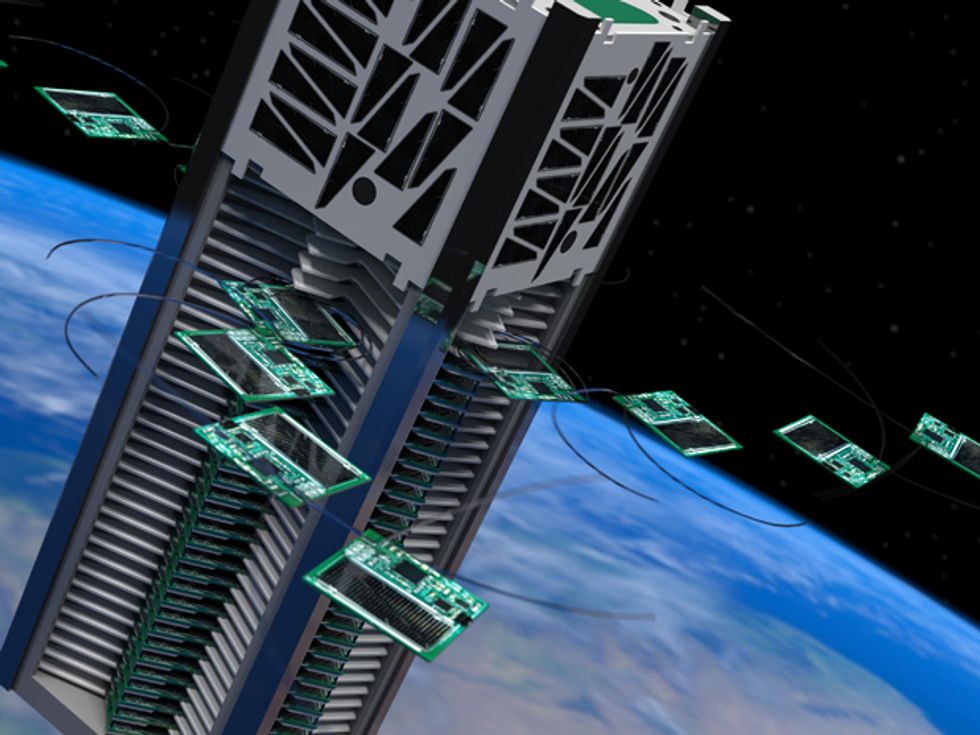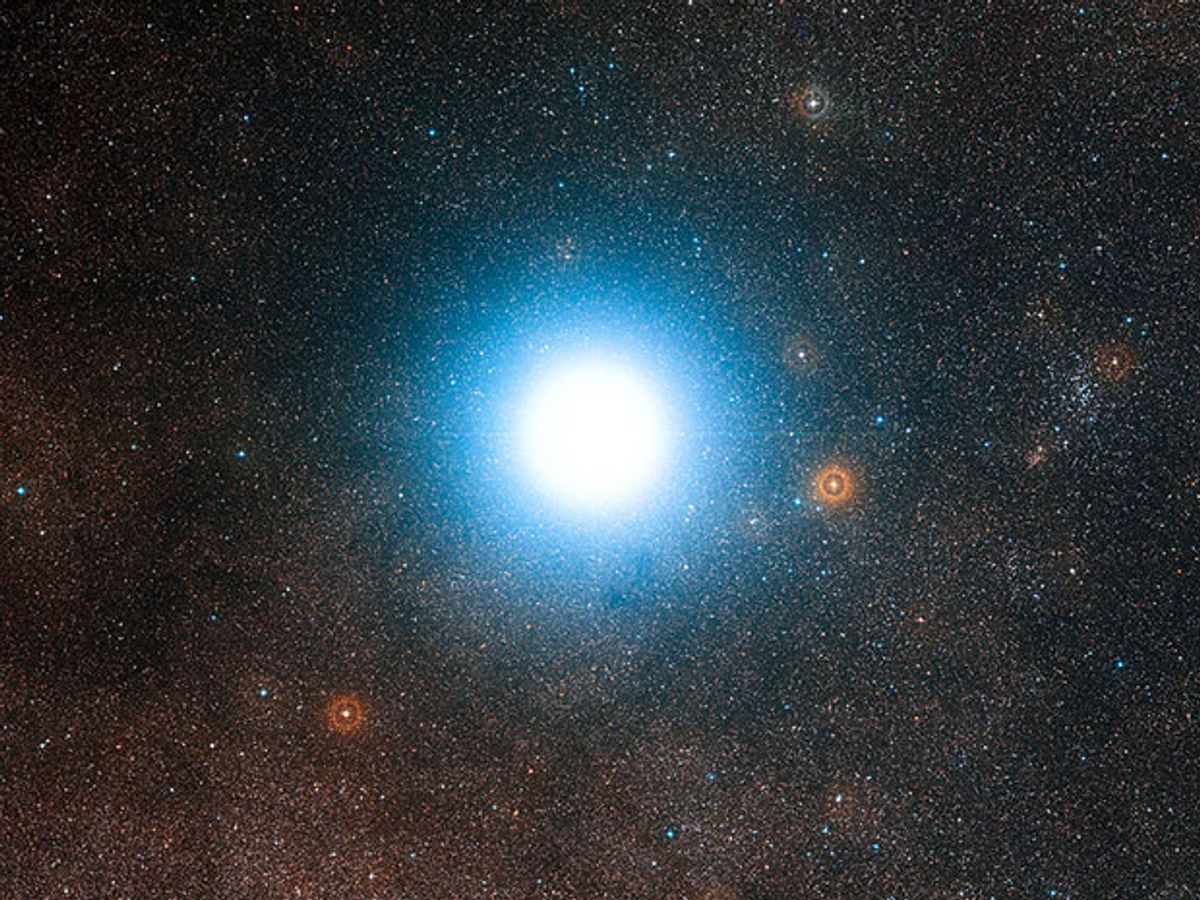In the 1960s, the physicist and space futurist Robert Forward proposed a radical method of sending a spacecraft to the stars. Roughly speaking, the idea was to attach the spacecraft to a large light sail, and then push it by illuminating the sail with an enormous laser. Forward suggested that a powerful laser could accelerate a spacecraft to a large fraction of the speed of light, allowing it to reach some of our nearest stellar neighbors within a few decades.
Until very recently, this idea remained solidly within the realm of science fiction. But today the outlook is beginning to change. In April, the physicist-turned-internet-billionaire Yuri Milner, together with Stephen Hawking and other notable scientists and engineers, announced that the Breakthrough Foundation would begin funding work on the concept of a laser-propelled starship, with the long-term goal of reaching the closest neighboring star system to our own, Alpha Centauri. Their initiative, dubbed Breakthrough Starshot, is a Silicon Valley take on Forward’s vision that imagines shrinking the spacecraft down to a mass of a few grams. A fleet of such “nanocraft”, each tethered to a light sail a few meters wide, could be economically launched into space and then accelerated toward Alpha Centauri with a terrestrial laser system. Illuminated by tens of gigawatts of laser light, the miniature spacecraft would reach 20 percent of the speed of light in about 4 minutes. After a 20-year cruise, they would zip through the Alpha Centauri system in a few hours and send data and images back to Earth from the brief encounter.
This might still sound like science fiction, but Starshot is by far the most realistic proposal for reaching another solar system. It would take, at best, tens of thousands of years to travel the 4.3 light-years to Alpha Centauri with chemical rockets. The other alternative propulsion strategies that have been proposed over the past several decades, including warp drives, nuclear fusion, and antimatter, have all been based on highly speculative technologies. In contrast, all of the fundamental technologies involved in Starshot are well understood, and there is a clear path forward. That said, there are several daunting engineering challenges will have to be overcome.
Perhaps the largest of Starshot’s technical hurdles is the laser system. As envisioned by University of California Santa Barbara physicist Philip Lubin, who has written a detailed concept study for this interstellar scheme, it would consist of a square-kilometer array of hundreds of lasers with a total combined power output on the order of 100 GW. The key to making this system work is the ability to sum together the outputs of many small lasers into a single coherent beam, something known as a phased array. To date, laser phased arrays have been confined to small sizes and modest power levels in laboratory experiments, however it is quite plausible that much larger versions could be built in the coming decades. According to data collected by Lubin, laser amplifier technology is advancing on a Moore’s-Law-like trajectory, with prices halving roughly every 18 months. And while 100 GW might seem extreme, the system only needs to operate for a few minutes to accelerate each craft (although it would consume about as much energy as a typical coal-fired power plant produces in a day in the process). Thanks to the drive toward solar and wind power, it’s not hard to imagine that we might be able to use a utility-scale energy storage system to save up and deliver the energy needed to power each launch.
In case you’re wondering, some care will probably need to be taken not to hit airplanes or satellites with the laser beam, although the situation won’t be quite as dangerous as it might seem at first. While the power of the beam is very high, it is initially spread out over an area of a square kilometer and doesn’t come to a tight focus until it reaches the light sail far out in space. Still, coordination will certainly be needed to ensure that air traffic is not disrupted and Earth-orbiting satellites are not blinded.
The nanocraft themselves present another challenge. Each will have to carry microprocessors, sensors, cameras, and power generation capabilities, and be able to withstand an acceleration of 60,000 g’s. The attached light sail will have to be a near-perfect reflector, absorbing less than 1 part in 100,000 of the laser’s light to avoid overheating. These are demanding requirements, but the technology we already have today suggests we should be able to meet them. First, “smart” artillery shells experience comparable accelerations while carrying sophisticated electronics and actuators. There has also been significant progress in spacecraft miniaturization in the past several years thanks to advances in consumer electronics. The smallest satellites, which can be made on a single circuit board, are now very close to the gram scale needed for Starshot. (In fact, a new batch of such tiny craft is slated to be sent to orbit next month.) Finally, advances in metamaterials should make it possible to fabricate thin sheets of lightweight material with the required reflectivity.
It took NASA’s New Horizons spacecraft nine years to reach Pluto. A nanocraft pushed from Earth orbit toward Alpha Centauri could traverse that same distance in less than 36 hours. It would then embark on a two-decade journey through unexplored interstellar space. The spacecraft will be bombarded by radiation and subatomic particles that could damage its electronics, as well as face potentially catastrophic impacts with interstellar dust. Given these hazards and the need to keep the spacecraft—including its shielding—very light, hundreds or even thousands of nanocraft will likely be sent over a period of several years in order to ensure that some survive the journey. Thankfully, advances in microelectronics should make the nanocraft relatively inexpensive and easy to produce in large numbers.

Upon reaching Alpha Centauri, there will be no possibility of slowing down. The nanocraft will have a few hours to take pictures and collect other measurements. Getting the data back to Earth over such vast distances will be another major challenge. You might think that a signal sent from Alpha Centauri would be hopelessly buried in the background noise of interstellar space, but it turns out that lasers can once again provide a solution. Thanks to much lower diffraction than radio waves, optical systems have much higher gain than radio systems of similar size. In fact, NASA recently performed a record-breaking laser communications demonstration at lunar distances as part of the LADEE mission. If the square-kilometer laser launch system can be made to double as a phased-array receiver, data rates of several kilobits per second could be achieved from Alpha Centauri with a 1-W laser transmitter on the spacecraft. It should even be possible to receive data at lower bit rates with the next generation of large optical telescopes set to come online in the 2020s.
Of course this all depends on having enough onboard power available to run the electronics. The nanocraft would likely be able to use solar power while in the vicinity of Alpha Centauri. However, during the long cruise phase something else will be needed. A betavoltaic battery or a miniaturized radiosotope thermoelectric generator could provide the necessary power in interstellar space. There are also some more exotic possibilities, such as harvesting the heat produced by the craft’s collisions with the interstellar medium and converting that heat into electricity.
Breakthrough Starshot is clearly a very ambitious project. Aside from the challenges detailed, several other key technologies—including interplanetary navigation, spacecraft pointing, and adaptive optics (to compensate for the effect of atmospheric turbulence on the laser)—must be pushed beyond their current limits. Still, this vision represents a realistic path toward the dream of interstellar spaceflight. If enough of us believe in that dream and work toward it, we may one day literally reach the stars.
Zac Manchester is a Postdoctoral Fellow in the Agile Robotics Lab at Harvard University and a consultant on Breakthrough Starshot. He is leading the KickSat project, which aims to deploy a group of 100 4-gram satellites into orbit this year—the launch is currently set for July. The mission is a reprise of an earlier, 2014 effort.



